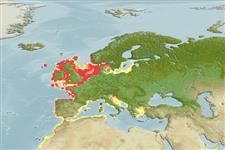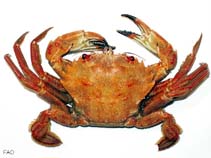Necora puber Linnaeus, 1767
Velvet swimming crab| Native range | All suitable habitat | Point map | Year 2050 |

|
| This map was computer-generated and has not yet been reviewed. |
| Necora puber AquaMaps Data sources: GBIF OBIS |
Classification / Names Common names | Synonyms | CoL | ITIS | WoRMS
Malacostraca | Decapoda | Portunidae
Environment: milieu / climate zone / depth range / distribution range Ecology
Benthic; depth range 0 - 80 m (Ref. 356), usually ? - 40 m (Ref. 435). Temperate; 4°C - 28°C (Ref. 112013), preferred 9°C (Ref. 107945); 61°N - 24°N, 16°W - 28°E
Distribution Countries | FAO areas | Ecosystems | Occurrences | Introductions
Atlantic and the Mediterranean Sea: From western Norway to the UK to Western Sahara and the Mediterranean coasts of Spain, France and Italy. Subtropical to temperate.
Length at first maturity / Size / Weight / Age
Maturity: Lm 4.8, range 4 - 5.95 cm Max length : 10.9 cm CL male/unsexed; (Ref. 96051); 9.84 cm CL (female); common length : 4.5 cm CL male/unsexed; (Ref. 435); max. reported age: 8 years (Ref. 96051)
Life cycle and mating behavior Maturity | Reproduction | Spawning | Eggs | Fecundity | Larvae
Main reference
References | Coordinator | Collaborators
SAUP Database 2006 SAUP Database. www.seaaroundus.org. (Ref. 356)
IUCN Red List Status
(Ref. 130435: Version 2025-1)
CITES status (Ref. 108899)
CMS (Ref. 116361)
Threat to humans
Human uses
Fisheries: commercial
FAO - Fisheries: landings | FishSource | Sea Around Us
Tools
More information
Max. ages / sizes
Length-weight rel.
Length-length rel.
Length-frequencies
Mass conversion
Abundance
Internet sources
BHL | BOLD Systems | CISTI | DiscoverLife | FAO(Fisheries: ; publication : search) | Fishipedia | GenBank (genome, nucleotide) | GloBI | Gomexsi | Google Books | Google Scholar | Google | PubMed | Tree of Life | Wikipedia (Go, Search) | Zoological Record



